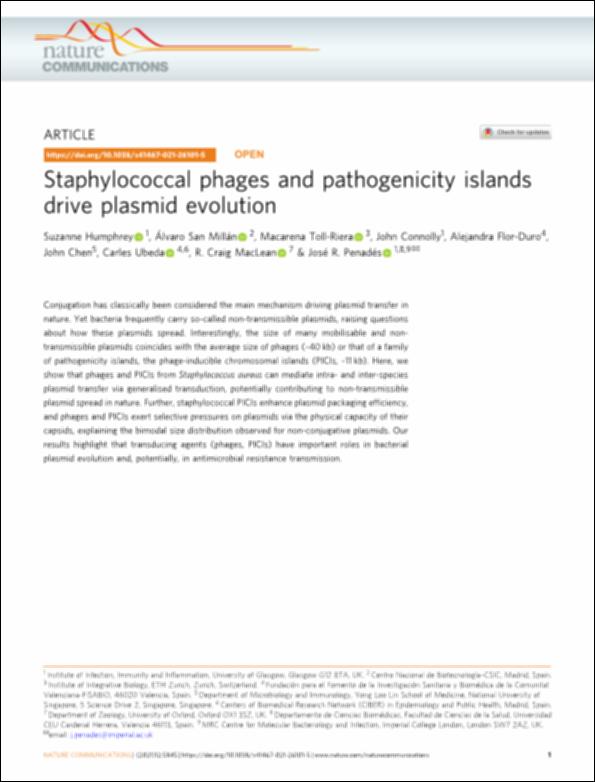Please use this identifier to cite or link to this item:
http://hdl.handle.net/10637/13679Staphylococcal phages and pathogenicity islands drive plasmid evolution
| Title: | Staphylococcal phages and pathogenicity islands drive plasmid evolution |
| Authors : | Humphrey, Suzanne Millán, Álvaro Sán Toll Riera, Macarena Connolly, John Flor Duro, Alejandra Chen, John Úbeda Morant, Carles MacLean, R. Craig Penadés Casanova, José Rafael |
| Keywords: | Bacterias patógenas.; Pathogenic bacteria.; Bacterial genetic.; Evolutionary genetics.; Bacteriophages.; Genética bacteriana.; Genética evolutiva.; Bacteriófagos. |
| Publisher: | Springer Nature |
| Citation: | Humphrey, S., San Millán, Á., Toll-Riera, M., Connolly, J., Flor-Duro, A., Chen, J., Ubeda, C., MacLean, R.C., & Penadés, J.R. (2021). Staphylococcal phages and pathogenicity islands drive plasmid evolution. Nature Communications, vol. 12, art. 5845 (06 oct.). DOI: https://doi.org/10.1038/s41467-021-26101-5 |
| Abstract: | Conjugation has classically been considered the main mechanism driving plasmid transfer in nature. Yet bacteria frequently carry so-called non-transmissible plasmids, raising questions about how these plasmids spread. Interestingly, the size of many mobilisable and nontransmissible plasmids coincides with the average size of phages (~40 kb) or that of a family of pathogenicity islands, the phage-inducible chromosomal islands (PICIs, ~11 kb). Here, we show that phages and PICIs from Staphylococcus aureus can mediate intra- and inter-species plasmid transfer via generalised transduction, potentially contributing to non-transmissible plasmid spread in nature. Further, staphylococcal PICIs enhance plasmid packaging efficiency, and phages and PICIs exert selective pressures on plasmids via the physical capacity of their capsids, explaining the bimodal size distribution observed for non-conjugative plasmids. Our results highlight that transducing agents (phages, PICIs) have important roles in bacterial plasmid evolution and, potentially, in antimicrobial resistance transmission. |
| Description: | Este artículo se encuentra disponible en la página web de la revista en la siguiente URL: https://www.nature.com/articles/s41467-021-26101-5.pdf |
| URI: | http://hdl.handle.net/10637/13679 |
| Rights : | http://creativecommons.org/licenses/by/4.0/deed.es |
| ISSN: | 2041-1723 (Electrónico) |
| Issue Date: | 6-Oct-2021 |
| Center : | Universidad Cardenal Herrera-CEU |
| Appears in Collections: | Dpto. Ciencias Biomédicas |
Items in DSpace are protected by copyright, with all rights reserved, unless otherwise indicated.


